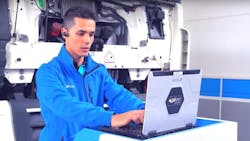Diagnostic tools are a technician’s sidekick
At 10 minutes before closing time, the last truck of the day comes in. It is a Volvo from one one of the local fleets, a larger company that normally takes its business elsewhere. You are surprised, but you go check it out. This could be a great opportunity to take on some of their business.
The problem turns out to be an aftertreatment issue. Your shop never works on Volvo trucks because you do not have the right tools. This was your opportunity to bring the customer in, but you have to reply: “I’m sorry, we don’t have the tools to work on a Volvo. You can head down to the dealer for them to check it out.” Just like that, an opportunity is lost. Maybe next time you will have the right tools.
Today, virtually every vehicle system is electronic or controlled by electronics. The days when trucks could be fixed without computers are gone, as are those where a shop could survive with just two or three OEM diagnostic platforms to repair most of the issues in the area. The industry has changed, and mixed fleets have increased, so why not change with it? Maybe it is time to give this some thought.
When we look at the field of repair, there is more and more complexity and, therefore, more confusion, frustration, and ultimately, many hours lost. Therefore finding an ally is key. Looking for and finding the right diagnostics tool is like finding a good second chair—the Robin to your Batman. Modern diagnostic tools cannot just be code readers that provide a code and then let the technician figure out the rest. The right diagnostic tool needs to be like a second technician: the one who looks up the operating specs, the one who remembers the procedure for changing an oil temperature sensor, the one who knows where the wires connect, etc. Your tool is your key to success.
When we look at diagnostic scan tools, there are some key elements to focus in on; elements that that might pass unnoticed but that can make a big impact in the bay. When looking at these tools, it can be easier to find the right one by focusing on three factors:
- For starters, look at the user interface. Using a diagnostics tool needs to be simple; it cannot be rocket science. The interface needs to be clean and intuitive. It should be easy to navigate and not take too long to learn. It should also be consistent across the board, regardless of the manufacturer, whether it is an engine or a transmission, or what year it is.
- The scan tool also needs to be able to service all makes. Many technicians are taught that the dealer is the best when it comes to diagnostics, but some all-makes tools are virtually dealer equivalent. Today, these tools cover roughly 98% of a shop’s needs and are capable of performing advanced actions that were previously only available at the dealer.
- Lastly, the right scan tool needs to offer more than just diagnostics. When we get in a jam, we can search for the right information on the internet, but are we looking at the right system? How can we be sure? The internet is not always a safe option while working on a client’s truck. Having the right information segmented by the right vehicle in the right moment is a key factor. It can mean the difference of knowing the specs and getting the torques right instead of using the “tight enough” approach we so often see.
When searching for a diagnostics tool, you need to know it is the right one—a tool that makes the technician better at what they do. It is important to measure these elements, know the ins and outs, and always have a support team when the task becomes too difficult. Cojali’s Jaltest is designed with these factors in mind, to help solve those issues and to never have to turn down a job.
Cojali has been an aftermarket provider in the heavy-duty industry for 30 years. Starting in the fan clutch business, diagnostics soon became the company’s primary focus. With an integrated all-makes solution, Cojali has helped shape the aftermarket diagnostics Industry. Bruno Gattamorta is the vice president of Cojali USA. With a background in engineering and an MBA, he has been catering to the aftermarket industry for the last five years, training customers, developing products, and being a part of this growing community.
About the Author

Bruno Gattamorta
Vice President | Cojali USA
Cojali has been an aftermarket provider in the heavy-duty industry for 30 years. Starting in the fan clutch business, diagnostics soon became the company’s primary focus. With an integrated all-makes solution, Cojali has helped shape the aftermarket diagnostics Industry. Bruno Gattamorta is the vice president of Cojali USA. With a background in engineering and an MBA, he has been catering to the aftermarket industry for the last five years, training customers, developing products, and being a part of this growing community.
